StarTech.com 8-bay USB 3.0 / eSATA Removable Hard Drive Enclosure Review
by Ganesh T S on August 11, 2015 8:00 AM EST- Posted in
- Storage
- USB 3.0
- eSATA
- DAS
- StarTech.com
USB 3.0 Performance
Similar to the previous section, we first check what ATTO and CrystalDiskMark have to report for an Intel SSD DC S3510 in the StarTech.com 8-bay hard drive enclosure, when connected via a USB 3.0 port..
A comparison against the numbers obtained with eSATA show that for sequential and 512K accesses, the UASP-enabled USB 3.0 connection fares better. However, for small-sized transfers, the eSATA version enjoys between 1.5x - 3x advantage in terms of transfer rates.
We repeat the robocopy benchmarks done in eSATA mode in the USB mode also.
- Photos: 15.6 GB collection of 4320 photos (RAW as well as JPEGs) in 61 sub-folders
- Videos: 16.1 GB collection of 244 videos (MP4 as well as MOVs) in 6 sub-folders
- BR: 10.7 GB Blu-ray folder structure of the IDT Benchmark Blu-ray (the same that we use in our robocopy tests for NAS systems)
| StarTech.com S358BU33ERM + Intel SSD DC S3510 (USB 3.0) robocopy Benchmarks (MBps) |
||
| Write Bandwidth | Read Bandwidth | |
| Photos | 214.01 | 246.69 |
| Videos | 214.96 | 318.15 |
| Blu-ray Folder | 223.71 | 323.02 |
The above benchmark run was also instrumented to record the drive temperature as well as instantaneous transfer rates during the process. The internal disk temperature never exceeded 37 C even after more than 127 GB of writes and 127 GB of reads continuously. Again, the above numbers indicate that the USB 3.0 interface performs better than the eSATA interface for large sized transfers.
For the second use-case, we take advantage of PC Mark 8's storage bench. The storage workload involves games as well as multimedia editing applications. The command line version allows us to cherry-pick storage traces to run on a target drive. We chose the following traces that we had already processed on the eSATA interface.
- Adobe Photoshop (Light)
- Adobe Photoshop (Heavy)
- Adobe After Effects
- Adobe Illustrator
Usually, PC Mark 8 reports time to complete the trace, but the detailed log report has the read and write bandwidth figures which we present in the table below. Since these are real-life workloads with plenty of small-sized transfers, the eSATA version performs better compared to USB 3.0
| StarTech.com S358BU33ERM + Intel SSD DC S3510 (USB 3.0) PCMark8 Storage Benchmarks (MBps) |
||
| Write Bandwidth | Read Bandwidth | |
| Adobe Photoshop (Light) | 240.17 | 61.49 |
| Adobe Photoshop (Heavy) | 241.45 | 71.75 |
| Adobe After Effects | 94.30 | 63.92 |
| Adobe Illustrator | 188.53 | 63.48 |
IOMeter Evaluation
The following graphs show the performance of the unit in USB 3.0 mode with multi-disk accesses for different workloads. We see the 128K accesses fare slightly better in USB 3.0 mode compared to eSATA mode, but the 4K performance is far worse.


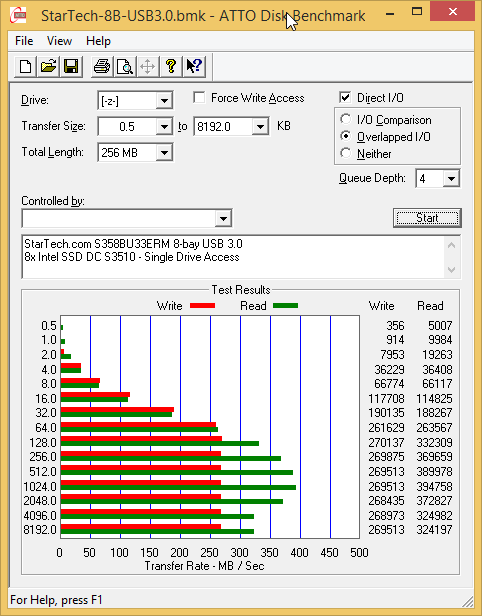
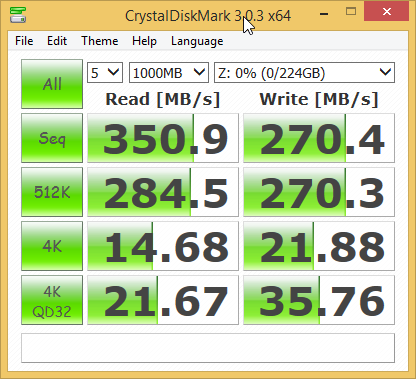

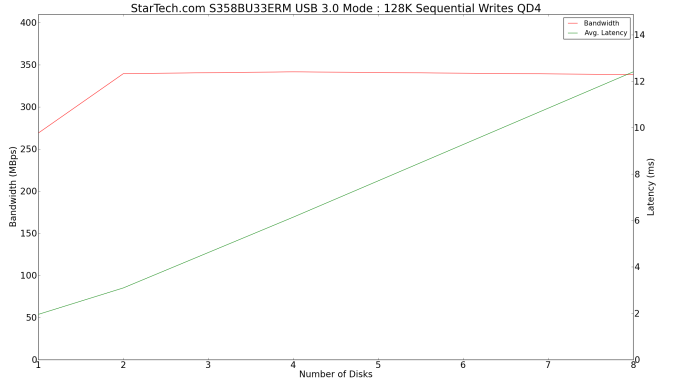
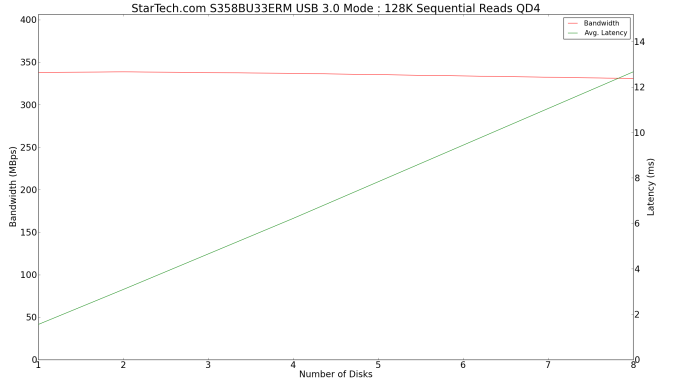
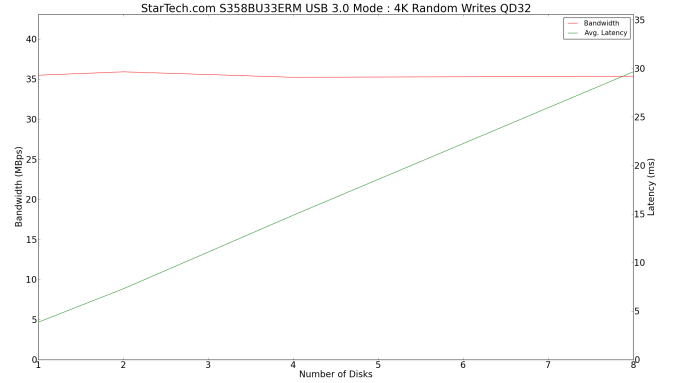
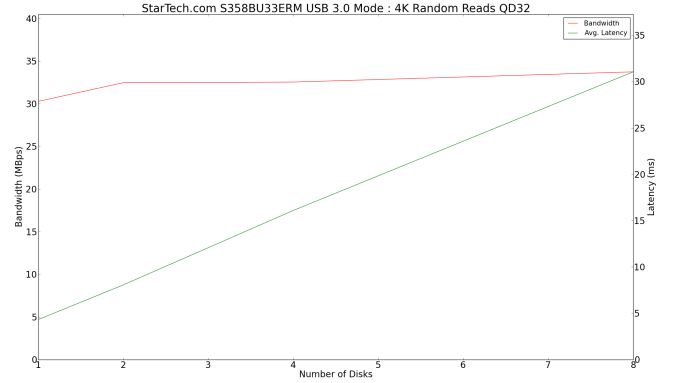








21 Comments
View All Comments
jardows2 - Tuesday, August 11, 2015 - link
Interesting product. As I was reading though, I kept thinking "How would I be able to use something like this?" I couldn't find in my mind any real scenario where this would be better than a NAS, until the last page where it was mentioned you could use this to help rebuild a RAID array. I'd love to see a more in-depth article/HOWTO on this process!dave_the_nerd - Thursday, August 13, 2015 - link
In general, this would be quite a bit faster than a NAS. So if you have any kind of data that's big but only needs to be accessed by a single computer (say, you're doing video production) these sorts of DAS enclosures are a pretty common sight.They're also useful for expanding a homebuilt NAS or file server.
Visual - Friday, August 21, 2015 - link
Um. Plug this in the USB port of most any home router made in the past decade, and you have a NAS.dhotay - Tuesday, August 11, 2015 - link
I don't see the value of testing this case with all SSDs instead of spinners. The thermal and power usage benchmarks are best-case scenarios, thanks to that decision.basroil - Tuesday, August 11, 2015 - link
Recently ran out of SATA ports on my tower and was seriously considering adding one of these devices to my collection. ~200MB/s write and ~100MB/s read is perfect for my photo/raw footage collection mid tier storage. Mind doing a few more of these on 5-10 drive switched enclosures? The cost savings compared to something like a drobo when all you want is direct attached storage is huge.Navvie - Tuesday, August 11, 2015 - link
I have a similar 4 bay JBOD e-SATA enclosure connected to my Gen8 microserver NAS. Adds more drive capacity without having to buy a new machine.I'd struggle to come up with any other use for them. Certainly my next NAS build will have more internal bays.
joex4444 - Tuesday, August 11, 2015 - link
DAS devices have a couple other uses. They are similar to external drives, though they might logically be a RAID device, so they let you choose which volumes are on based on your current needs. This is good because it saves power and reduces noise. Further, if you can use DAS devices to have a single SSD in your build and all your hard drives in the DAS then you reduce the amount of heat in your PC. I'd much rather have 8 drives in a separate box with a separate PSU and fan than try to get my tower to also stay cool with 8 HDDs stuffed in it, which also impede airflow as they dump extra heat into the system.karpodiem - Tuesday, August 11, 2015 - link
Is it possible to do software RAID6 in Linux if all eight drives were empty?digitalgriffin - Tuesday, August 11, 2015 - link
With ZFS you could. However this eSATA enclosure chip only has hardware JBODfackamato - Tuesday, August 11, 2015 - link
So software RAID6 in Linux would work great then?